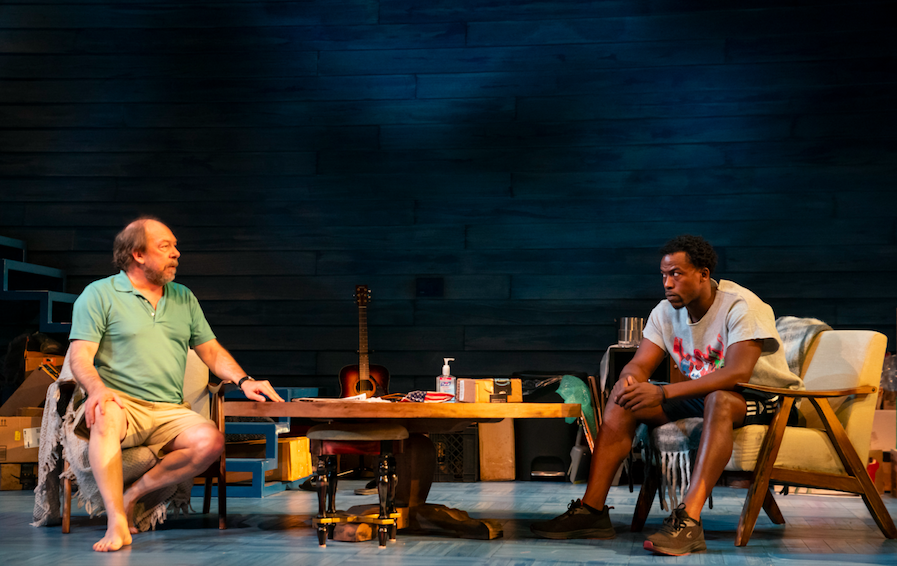Transposing classic plays into modern eras has been an accepted theatrical technique for quite a while now. Moving these timeless works into a contemporary setting can illuminate their universal themes and bring insight to current issues. But these time-warp productions have mostly been for Shakespearean texts. Few more recent classics have switched time frames, probably because we are too familiar with their original settings to accept any updating. Recent exceptions have been stagings of such 20th century favorites as The Crucible and The Little Foxes by the innovative Belgian director Ivo van Hove and an updating of the beloved musical Oklahoma! by Daniel Fish. Some theatergoers have howled in protest at these changes as imposing a director’s vision on a pristine piece of art. But the new versions did reveal interesting aspects of the reset works and unexpected views of our own era.

Credit: Joan Marcus
Such is the case of Robert O’Hara’s radical re-imagining of Eugene O’Neill’s mammoth autobiographical family portrait Long Day’s Journey Into Night for Audible at the Off-Broadway Minetta Lane Theatre. First performed posthumously in 1956 in Stockholm and subsequently on Broadway, this four-act marathon exposes the lacerating effects of alcoholism and drug addiction of the tortured author’s dysfunctional family during one summer day in 1912. O’Neill’s father was a matinee idol who squandered his talent by playing in a hack melodrama. His mother became addicted to morphine as a result of pain suffered when he was born. His older brother died an alcoholic wreck and, as a young man, O’Neill himself suffered from illness and suicidal depression.
There have been six Broadway productions of this searing drama as well as a devastating film starring Katharine Hepburn, Ralph Richardson and Jason Robards and numerous TV and London iterations. All adhered strictly to O’Neill’s script, but O’Hara has dared to deliver a pared-down Journey set in 2020, and though the changes don’t always work, this is still a wallop of a play.

Credit: Joan Marcus
Reduced from four-plus hours to an intermissionless two, the production’s impact is more like a short, sharp jab to the gut rather than a pummeling to the psyche. In O’Hara’s rendition, the fictional Tyrones are living through the COVID quarantine, their confinement echoing their state of imprisonment by their past. Mother Mary’s morphine addiction suggests the modern opioid crisis. Younger son Edmund’s dire prognosis of consumption (or tuberculosis) is replaced by the threat of COVID itself. Even father James’ status as a theatrical star on summer break fits in with the contemporary setting as his hiatus parallels the Broadway shutdown. Clint Ramos’ abstract, evocative set is cluttered with Amazon packages and NK95 masks and the play opens with CNN clips of pandemic and Trump news (Ramos also designed the appropriately super-casual costumes.)

Credit: Joan Marcus
O’Neill’s tragic vision becomes powerfully contemporary under O’Hara’s muscular direction and four insightful performances. (The fifth role, that of the Irish maid Cathleen, has been eliminated. The meals she served have been replaced by take-out deliveries.) Bill Camp and Elizabeth Marvel, married off-stage, create a believable bond onstage. It’s clear this couple still love each other, even though they blame the other for their current misery. Camp is entirely credible as formerly commanding Shakespearean actor and clearly delineates James’ inner war between his love for his family and his disappointment in them. Marvel is indeed marvelous as the addicted Mary. From Hepburn to Vanessa Redgrave to Jessica Lange, most actresses playing the role have retained their theatrical glamour, but Marvel is not afraid to show the more realistic, ugly side of the character. Mary’s final morphine-laced monologue is usually played as a grand lady moment with the star in a spotlight and the curtain falling amid bravos, but Marvel mumbles through it, crawling on the ground and finally collapsing as a true dope fiend would. It’s a shattering rethinking of what has become standard-issue Tony Award bait.
O’Hara has interestingly cast the two sons, Edmund and Jamie, with African-American actors while the parents are played by white performers. It could have been a color-blind choice, but it does emphasize the separation between the generations and the family’s status as social outcasts in their snooty Connecticut town. Ato Blankson-Wood captures Edmund’s desperate displacement and sense of being an outsider while Jason Bowen powerfully portrays the older brother Jamie’s self-loathing.
Additional non-traditional and effective elements include Yee Eun Nam’s projection design which gives visual expression to Mary’s drug-induced head trips, and Alex Jainchill’s ethereal lighting. This is definitely not your father’s Long Day’s Journey, but it is O’Neill’s, rethought for the 21st century.
